By Paul Comben
Grand Tactical Interpretations of Quatre Bras
Part II
Desperate Times and Desperate Measures
Wellington had precious little cavalry available to him during the battle. Those that were present included the Brunswick Legion’s contingent, which contained about a thousand mediocre troopers, to which could be added a few hundred Dutch-Belgian mounted men in the 5th Light Dragoons. Despite the difficulties this caused on the day, it may well have been a blessing in disguise that no elite British cavalry got a chance to “Leather the French” at Quatre Bras. The Lord alone knows where they might have ended up – blown or blown up somewhere near the border might be a not too unlikely assumption. In any case, the cavalry was present when the Duke needed it most – covering the retreat to Mont St Jean and breaking the columns of D’Erlon’s corps in the early afternoon of Waterloo.
The one complete cavalry unit available to Ney was the II Corps’ integral cavalry division led by the capable Hippolyte Piré. This force numbered a little over two thousand men, including two regiments of lancers. Because of the lancers’ longer reach, and the unnerving effect hundreds of these men would have when at the charge, such a unit could be a very effective weapon. But against experienced and steady cavalry, or formed squares of determined men, their impact was far less pronounced. In close quarters fighting against the cavalry sabre, the lance became a cumbersome liability. Properly comported infantry squares could also readily withstand a lancer attack, but if infantry were caught in the open, the results could be catastrophic.
Near enough to be called on, Ney also had part of Kellerman’s III Reserve Cavalry Corps – heavy assault cavalry, with a serious presence of cuirassiers. These may have eventually numbered up to another eighteen hundred men, although for much of the battle only a portion of this was actually on the field. The Guard Lancers (the “saved for later” contingent) would have numbered around nine hundred men, but it is highly unlikely they were involved in anything more than hostile milling about, or that anyone from their contingent got really close to the enemy save the guns of the horse artillery.
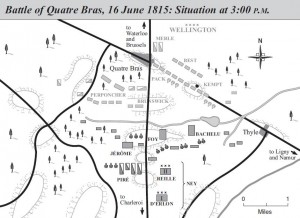
“Battle of Quatre Bras map” by Gregory Fremont-Barnes (main editor) – Gregory Fremont-Barnes (main editor) – The Encyclopedia of the French Revolutionary and Napoleonic Wars, page 800. Adapted from Chandler 1999, 353.. Licensed under Attribution via Wikimedia Commons –
In a dismally prophetic curtain-raiser to events at Waterloo, Ney’s handling of his forces’ attacks at Quatre Bras showed precisely the same failings as would be manifest on June 18th. In particular, he failed to support several promising cavalry charges with any accompanying infantry. From the French perspective this was especially unfortunate given the Anglo-Allied infantry at Quatre Bras experiencing a marked number of tactical shortcomings when faced with cavalry closing in on them. Squares were not formed in time, or were compromised by either the eagerness or the ineptitude of certain officers. Failure to distinguish friendly foreign cavalry from hostile foreign cavalry also played it part, and as a result, there were occasions when French cavalry got in amongst open order British infantry, and in one famous episode, entered the still forming square of one British regiment, only to get trapped there, and, unassisted by any closing French infantry, was eventually wiped out
That such opportunities all went to waste was hardly surprising considering that as the hours went by, Ney showed every sign of “losing it” big time. With D’Erlon proving hard to get, and Wellington proving hard to beat, coherent orders gave way to fulminating rhetoric as Ney plotted strategy by shouting at people and demanding miracles from whatever cavalry came to his attention. Of course, invoking the honour of France was no more going to dislodge Wellington than reciting Greek verse, but that was pretty much the extent of Ney’s command efforts. He essentially wanted D’Erlon units not because he was keen to do something brilliantly subtle with the corps, but simply to have something different to chuck at the detested English.
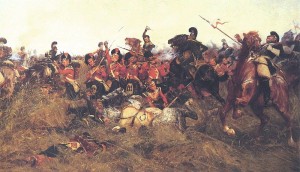
Black-Watch at the Battle of Quatre Bras under attack by French Cuirassiers (William Barnes Wollen) – Wiki
When I read of the cavalry actions at Quatre Bras and Waterloo (Ligny was largely about fortified villages and street fighting, and Wavre just happened and went away), I do find cavalry modeling in the grand tactical wargame environment is asked to do more than you might expect if it is going to be able to act out all that actually happened. Quatre Bras saw cavalry charges occur just the way you might imagine them – charging unit, target unit, bit of momentum…easy. The cavalry fight in the main street of Genappe the following day was again a simple matter (!) of charge, counter charge and melee. The charge of the Household and Union brigades was again pretty straightforward because all the Brits went straight forward and would not come back when they were called. But the French charges in the later afternoon were odd – not only because they were led by a man who meant inevitable death to any horse he got on, but because they were often not really charges as the term might commonly be understood. This led to situations that many an author has written about, but still remain rather hard to picture in the mind.
I am about to wander somewhat off topic, but this material is worth a look. Frankly, you can have all the charge mechanisms you like – charges proceeding after a morale check, squares formed, more morale tests and get the shock table ready, but does that really cover what went on for about two hours (4pm – 6pm) at Waterloo? Wherever I have seen cavalry as a force in detailed tactical games, whether it has been at some ancient epic of a battle, a medieval clash, or a Napoleonic slamming match, there have been certain things in common – cavalry charges a target, prevails or is repulsed, and in the former case, may go on to use momentum to attack something else. See Waterloo the movie and that is what you get, or may at least infer – the cavalry thunders forward at the gallop, goes for this square or that, gets nowhere and then goes back and tries again. But it was not like that. Not at Waterloo. Not all the time.
Here are the quandaries:
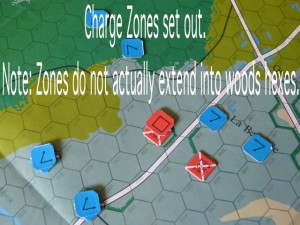 The period of French cavalry charges, according to not a few accounts, seems to have started without anyone giving a direct order to many of the involved formations to launch an attack. Ney may have ordered a limited force forward in that spluttering martial Newspeak of his, but no one else’s recollections tie up, beyond the belief that some of Milhaud’s cuirassiers were told to launch a probing charge. It is an interesting piece of potential colour, that ordering just a portion of your cavalry forward may prompt a wholesale charge over which you have no control at all. How you would model that in game terms may require trial and error, but would certainly not be impossible.
The period of French cavalry charges, according to not a few accounts, seems to have started without anyone giving a direct order to many of the involved formations to launch an attack. Ney may have ordered a limited force forward in that spluttering martial Newspeak of his, but no one else’s recollections tie up, beyond the belief that some of Milhaud’s cuirassiers were told to launch a probing charge. It is an interesting piece of potential colour, that ordering just a portion of your cavalry forward may prompt a wholesale charge over which you have no control at all. How you would model that in game terms may require trial and error, but would certainly not be impossible.
The counter to what may be perceived as a mere piece of fantasy, comes in the form of stark military reality and practice – that orders are needed to move units that have no good reason to move themselves. In this context one might ask: why would Kellerman and his cavalry corps be prodded into action, and the Guard heavies with them, simply because far away in the distance, and perhaps not that visible, another formation was moving to the attack? Then again, who knows what Ney was doing, and how his huffing and puffing had affected (or infected) the nature of French command at Waterloo? Maybe indicative than some form of unthinking enthusiasm had indeed overtaken the French cavalry, one may refer to the despairing figure of Kellerman, who, before riding off after the greater part of his corps, told Blancard, the commander of the eight hundred carabiniers of III Cavalry Corps to remain in place, being as they now were the last uncommitted mounted reserve the army had. It is even possible that a disapproving Napoleon (his words in relation to the initial cavalry movement: “Ney is attacking too soon”) ordered the extra commitment himself, with this latest rush of blood forcing his hand – in for a penny, in for a pound.
Whatever the answer, the French cavalry attacks on Wellington’s line soon took on a distinctly unusual guise. They may have each started in a sort of galloping fury, but thereafter there was nothing going on or about the plateau but masses of French cavalry pacing about between the squares, feinting, scowling, and just occasionally jabbing out, in what was a giant game of dare. As has been quoted in many histories, Wellington’s infantry saw these periods as being a welcome relief from the bombardments of the French artillery, as very little hurt was received. Likewise, the French cavalry was not receiving that much return fire, as keeping the musket loaded was all part of the game. And although the presence of the French cavalry was challenged initially by the remaining cavalry forces under Uxbridge, the efficacy of the French batteries and the readily expended élan of at least some of the remaining Allied cavalry, meant that the counter charges soon petered out.
Finally, there were all those abandoned Allied batteries. The gunners had either made for the nearest square as charges commenced, or, in some cases, had just plain run off. The Duke, as he later readily admitted in regard to the fleeing gunners, was far from amused. In any case, the guns themselves were of course in a highly vulnerable position, and could have been towed away, spiked, or rendered useless by the carrying-off or breaking of their sponges and rammers. But none of this was done, and the oversight can only be described as the work of temperamental thoughtlessness. Had the guns been rendered inoperable, the consequences may well have been worth the harm done to the cavalry, but as it was, when the charges ended, both Wellington’s infantry and his remaining artillery were still in place.
Can you recreate these factors with either system?
In Ney versus Wellington the heart of the cavalry charge system is the charge zone. This is marked out with counters bearing divergent arrows, which, in turn, define a broadening “funnel” six hexes deep. The counters are placed as soon as a cavalry unit has passed the requisite morale check and is put to a charge. The zone itself then becomes a piece of game world “inner space,” with its own rules and its own time flow – reflecting the pace of the charge in relation to what is occurring in front of it. Movement rates for units in the zone (not the charging cavalry or any counter charging unit) are put into a sort of slow motion – which is part of the depiction of contrasting unit speeds within the zone, as well as reflecting someone like me trying to remember all the relevant rules.
Overall, I find the charge system in the Wellington’s Victory series a mixture of very sound ideas and some rather lackluster ones. The positives include the nature of the charge zone itself, as well as the procedures for counter charge and opportunity charge – counter charge is against a charging enemy unit coming within reaction range of opposing mounted units; opportunity charge is against anything else that so presents itself. Charges can continue via the momentum of successful results over a considerable distance, and thus, potentially, do a great deal of damage against weakened or unprepared adversaries. Furthermore, built into the charge structure is a test, via morale check, to see if formations of enemy infantry not yet in square can adopt that status. It is not exactly spelt out, but it is there – if troops that are presently in column or line check morale and fail, the ensuing disorder will prevent them forming square at all…and serve them right for waiting too long.
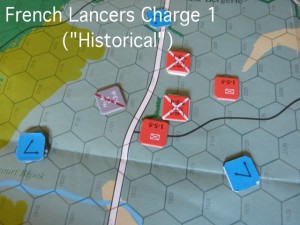 As for the weaknesses of what is presented, there is no notion of cavalry becoming blown – cavalry does become disordered at the conclusion of a charge, but that is not really the same thing as they can often recover in a trice. Historically, blown cavalry could easily be finished for the day; it may have taken numerous charges and feints, but once that limit was reached, that unit was done with. Another weakness links to the opportunity/counter charge logic. As I have argued in another article, (on Medieval cavalry), the notion of opportunity charges and the like should ideally be partnered by tests to ensure that you do not see something performed against the inclination of the overall commander (the player), but more in line with the disposition and inclination of the troops. This is not new stuff; it rather ties in, after all, with the pursuit rules in Ben Hull’s Musket and Pike series – one thing deliberately to send cavalry on their way, another to stop them going off on wild pursuits, or then hope they come back afterwards.
As for the weaknesses of what is presented, there is no notion of cavalry becoming blown – cavalry does become disordered at the conclusion of a charge, but that is not really the same thing as they can often recover in a trice. Historically, blown cavalry could easily be finished for the day; it may have taken numerous charges and feints, but once that limit was reached, that unit was done with. Another weakness links to the opportunity/counter charge logic. As I have argued in another article, (on Medieval cavalry), the notion of opportunity charges and the like should ideally be partnered by tests to ensure that you do not see something performed against the inclination of the overall commander (the player), but more in line with the disposition and inclination of the troops. This is not new stuff; it rather ties in, after all, with the pursuit rules in Ben Hull’s Musket and Pike series – one thing deliberately to send cavalry on their way, another to stop them going off on wild pursuits, or then hope they come back afterwards.
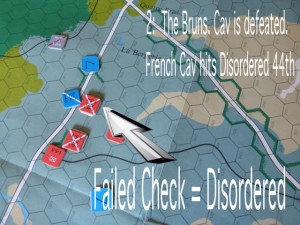 Another aspect of weakness in the approach is the nature of certain rule generalizations, the better finessing of which would hardly put a burden on the gameplay. One place where this can be found is in the statement that infantry in square is never tested for morale in the aftermath of a hostile charge declaration. This just does not tie in at all with historical experience. Again, referred to in my Medieval cavalry article, were instances of “infantry fidget” in British squares of the Napoleonic era when faced with hundreds of cavalrymen coming towards them. Squares not infrequently lost cohesion because of fear in the ranks, and both Quatre Bras and Waterloo saw instances of troops already in square compromising their defence by such means. Taking away the possibility of a square breaking under duress of a cavalry approach is not a good idea, and simply requiring said units in a charge zone to check morale (maybe with some modifiers either way) along with everyone else would probably be enough to put matters right.
Another aspect of weakness in the approach is the nature of certain rule generalizations, the better finessing of which would hardly put a burden on the gameplay. One place where this can be found is in the statement that infantry in square is never tested for morale in the aftermath of a hostile charge declaration. This just does not tie in at all with historical experience. Again, referred to in my Medieval cavalry article, were instances of “infantry fidget” in British squares of the Napoleonic era when faced with hundreds of cavalrymen coming towards them. Squares not infrequently lost cohesion because of fear in the ranks, and both Quatre Bras and Waterloo saw instances of troops already in square compromising their defence by such means. Taking away the possibility of a square breaking under duress of a cavalry approach is not a good idea, and simply requiring said units in a charge zone to check morale (maybe with some modifiers either way) along with everyone else would probably be enough to put matters right.
And what about the cavalry’s milling and swirling about? Here, a bit of fudging and creative thought is probably required. That a phasing cavalry unit undertaking a charge must move a minimum of three hexes from its starting hex does not sit well with being faced with a line of enemy squares walling off the deeper parts of the charge zone. The only way one can work with this is to keep attacking within the zone (you can do this) until either a charge ending negative result is obtained against the original attack unit, or you clear a path and move on. This is not milling and feint, but potentially a cavalry can thread between enemy units and end up in the military back of beyond. At Waterloo, and at Quatre Bras, French cavalry did go on these sort of meandering escapades – at least some French cavalry at Waterloo went around the rear of Wellington’s position between the Brussels and Nivelles road and returned to the French lines by passing to the west of Hougomont. And at Quatre Bras French cavalry did reach the crossroads, milled about, and then had to return again the long way around.
What about the La Bataille interpretation? At first glance, the rules for cavalry charges included the “basic” La Bataille sets can look a touch intimidating, but if you have any sort of decent familiarity with the SPI charge rules, you are going to recognize some shared structures and notions. How charges are initiated, and the effect on units “in the way” are not so very different. What is different is that everything is given a bit more notice and detailing. Attempts to form square at the last moment are subject to nasty modifiers; lancers do their best work when deployed in line; cavalry “burn-out” can be lessened by precise decisions on squadron commitment; and in a marked change from the SPI rules, cavalry, albeit with the penalty of being potentially popped at from all over the place, can ride over (actually around) a square and look for victims further on.
If you opt for the Regulation XXII rules, you will get even more cavalry detailing, but for me, what I have with the games “as is” is quite enough. Of course, that is not the same as saying this situation is perfect, or that I agree with every last thing applied. Again, infantry already in square, even a very little one, are automatically considered as resolute as Spartans when it comes to facing a tide of hostile cavalry. I really do not buy this; undoubtedly, a square is going to confer combat and morale benefits, but not right up until you run out of sides and corners. And it is not as if Wellington’s army was so richly supplied with undaunted battalions – strength gets sapped, men get tired, and not a few do not want to be there in the first place.
With a greater sense of doubt as to my position, I am also a bit wary of the rate at which cavalry recovers from exhaustion/tiredness. In the final section of this study, I will look at both victory conditions for the Quatre Bras games, and how the stress of hours of combat is represented as wear and tear builds upon the armies engaged – and here I am talking about more than casualty points. For now, I will simply refer to the incurring of penalties for cavalry usage, and how negative status is lost after it has been imposed. Basically in La Bataille, a charge action conducted by cavalry (the only way they can shock) increases the unit’s fatigue level – from Fresh to Tired to Exhausted. With turns coming in at twenty minutes duration, recovery from exhausted (no charges allowed and rotten melee strength) will take an hour of doing nothing with your mount but standing somewhere safe listening to the band. Certainly this is better than the utter lack of provision in the SPI series, but I am inclined to think that certain levels of fatigue and casualty should not permit recovery within the timespan of any grand tactical game. What was left of the Household and Union brigades did nothing for the rest of the day after their one wild gallop at Waterloo; and likewise, although two hours after the very last of their charges, precious few French cavalry went forward to do anything as the Imperial Guard made their final attack.
“What Would They Say In England?”
Quatre Bras began with a major crisis for Wellington, as whilst he was more or less there as the battle began, near all his army was not. At Waterloo, he faced several crises as French attacks came in, but the ultimate moment of decision did not come for hours, when the grisly process of attritional wearing saw his line finally ready to snap.
What these contrasting situations indicate is that crisis and defeat for an army can come from more than simply an accrual of casualties. The disadvantage of a bad position, scattered forces, commanders on the back foot, or already, by their outlook, more than half beaten, poor troops or troops lacking motivation, all of these things have contributed to the outcomes of battles as much as simply killing and incapacitating an enemy by use of weapons.
In the wargame environment, victory conditions can be one part of the design process where things can go seriously awry. We have all played games where victory for one side or another has come one die roll ahead of the other side claiming victory themselves. In other cases, irrespective of what the “feel” of the battle situation is, one side, by grabbing this point or that, may claim victory even if a longer run of time might see them in serious difficulty. And we have all seen YouTube films where one of our fellow gamers has suddenly said, and this with a notable air of surprise: “Oh, that’s it, game over. Apparently, they win if they’ve done/got XYZ, and there you are. Finished.”
Victory conditions naturally need to fit historical parameters, and be in accord with what the opposing sides were trying to do. And naturally, casualties, losses, are going to play a part in how objectives are achieved, or whether they can be achieved at all. The battlefield environment is a place of stress, despair and horror – and yet, at times, also of wild elation and “trippy” delusions. The story of Quatre Bras, or of Waterloo, is very much this story of hope, horror, despair and harm, and we should begin with the presentation of losses in the two systems.
At the level of the individual unit, the wear of battle is presented in casualty step losses (by numerical marker) and the degrading of formation and morale status. The one small difference between the two systems is that unit strength for cavalry is expressed in units of fifty in La Bataille, whereas the rest of the forces in the two games are in units containing steps of one hundred. All artillery formations are represented by battery counters. Alongside the representation of strength and loss of strength, there is the matter of formation status and morale. This may provoke “losses” from a unit through desertion/straggling, but is also associated with unit efficiency and willingness to remain in the fight. We 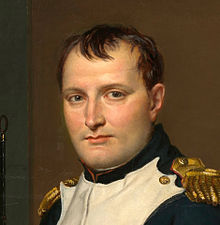 may think of casualties induced being an end in itself, but the fundamental aim is actually to break the will to resist. In numerous battles throughout history, victory has not always gone to the side with the fewer casualties, but to the side still willing to fight, and this with the capacity so to do. And not all defeats take the same shape either – Napoleon was routed from the field at Waterloo; but with a similar sized army and similar casualties, Lee was able to make an orderly retreat from Gettysburg accompanied by men who had little notion of defeat, and in fact, might yet try to claim to having gained a victory of sorts.
may think of casualties induced being an end in itself, but the fundamental aim is actually to break the will to resist. In numerous battles throughout history, victory has not always gone to the side with the fewer casualties, but to the side still willing to fight, and this with the capacity so to do. And not all defeats take the same shape either – Napoleon was routed from the field at Waterloo; but with a similar sized army and similar casualties, Lee was able to make an orderly retreat from Gettysburg accompanied by men who had little notion of defeat, and in fact, might yet try to claim to having gained a victory of sorts.
Let me now return to Waterloo just for a moment, and at that time in the battle when the Imperial Guard was cresting the ridge of Wellington’s position. The Duke had started the battle with around 70,000 men, along with 157 cannon. His total casualties (killed and wounded) during the battle are reckoned in today’s accounts to have numbered somewhere over 17,000; and to this could be added, by common account, some 10,000 men either permanently or temporarily fled from the ranks. That should have left Wellington with well over 40,000 men to face the final French assault. But he did not have 40,000 men; he may, in fact, have had a few as 30,000 along his entire line. In addition to which, his artillery was in utter disrepair – many of the batteries were entirely out of ammunition, and in these cases, or in others, the crews had fled. Some batteries only had a few guns still firing, with the others neglected as recoil after recoil had left them isolated and pointing at nothing. Wellington, by his own admission, entered the last phase of the battle supplied with capable artillery only from those few batteries that had been held back in a last reserve.
But after allowing for blood casualties and obvious cases of fleeing the field, where were the rest of the missing? The answer to that could have been seen, on the day, around the buildings of Mont St Jean village, on the road to Waterloo, and in Waterloo itself. Here, as much as anything, I am referring to the military culture of the times – and very different times to the age of Caesar, when a wounded Roman soldier could be rapidly extricated from the line by efficient army paramedics and got to a field surgeon in very quick time. By contrast, some wounded fellow at Quatre Bras or Waterloo was likely to have any one of a number of experiences depending on which army he belonged to. In the Duke’s army, whether a soldier’s wound was relatively light or more severe, he was only going to be helped on his way by the intervention of those about him, who naturally saw this as the best course for self preservation, and would often, as Clayton cites, gather in droves around some wounded fellow and accompany him to the rear. Needless to say they rarely hastened back; and in fact, the only things missing from their displays of concern for the afflicted were a bunch of flowers and some grapes.
The odd thing is, neither the British army of the time, nor any other, it seems, did much to prevent this farewell to arms. In fact, there seemed to be precious little objection to men accompanying a stricken comrade back to dressing stations. The French tried to make it all more efficient by means of the Larrey ambulances, but that service was not at optimum efficiency during the campaign, and at Waterloo, was simply overwhelmed as many of the hastily recruited drivers fled. As for the Prussians, strung out after a long and difficult march, their arrangements for casualties were ad hoc to say the least.
Try as I might, I remain skeptical as to whether either system is ready to degrade an army as much as it should when the fighting gets rough. Of course, we should all recognize that a step lost to any battalion is not simply a hundred dead or even a hundred dead and wounded. It is also meant to reflect men being shook loose from their parent unit for whatever reason – only it does not seem enough. I daresay those who have played these games with dedication will have their own opinions as to how realistically armies are hollowed out by engagement and losses; but even if their results tally with what presents as the historical realities, there is still the question of whether this result is attained by the right means? By this I mean that both systems cater for armies as a whole reaching a point, or in La Bataille, stages, of demoralization through accrued casualties – note: also cut from Ney versus Wellington was the committed formations rule seen in Wellington’s Victory. But whatever the systems do contain, it is not the same as acquiring a mindset of impending doom, and is still overly linked simply to being shot at.
Turning again to Waterloo, even when the French I Corps had been driven back in disarray, there were Allied soldiers in the streets of Waterloo saying that all was lost. Later, with the squares holding out against the French cavalry, it was the turn of The Duke of Cumberland’s Hussars to head off to Brussels, where they joined other troops readily telling everyone that defeat had undoubtedly happened.
It might be said in response, that both systems have mechanisms that can cover the departure of an entire unit, with the player left to make up a story if they wish as to what precisely occurred. In actual fact, however, I am talking more about the “evaporation” of units as soldiers here and there decide the time to depart is upon them. Not everyone leaves on the same turn; and on some turns, no one from a given unit might leave at all. Overall, however, once the mindset, the urge and inclination to be elsewhere, has taken hold, the unit is likely to shrink away to nothing.
This has been crudely represented is some games over the years. I seem to recall the old Alexander the Great from Guidon/Avalon Hill had a rule which meant that once army morale passed a certain point, all the army’s mercenaries packed up their spears and left. For a subtler “melting away” it might be thought I would be proposing an administrative nightmare in the game, but I do not see any need for that. A straightforward phase in the game turn where an army in a negative morale state must shed a number of strength points from particular qualities of units would be quite enough. But neither system has the like.
When it comes to victory conditions, objectives and command mindset should be very much treated as one if we are to make sense of the battle environment. And it helps if we know enough of the battle’s broader aspects that we can evaluate for ourselves those victory conditions the game presents.
For Ney the first job was to capture Quatre Bras and defeat whatever he found in the way. However, the broader historical perspective, as well as Napoleon’s clearer train of thought, looked beyond the capture of the crossroads to the envelopment of the Prussian right flank. Both therefore would have had cause to feel better about things had the I Corps been with them. As for Wellington, intentions to assist Blücher soon went out the window, leaving the objective of holding the crossroads for the sake of his communications and bringing his army to full concentration.
In Ney versus Wellington perceptions of winning and losing are tied purely to the battlefield of Quatre Bras. French forces advanced north of the Namur Road are not linked to any operational benefit with regards to Ligny, but are merely indicative of Wellington having been pushed back – and all the better if his force is demoralized. As for the Duke, he needs much the same…but going in the opposite direction – the French shooed away from Quatre Bras, nothing north of the Namur Road, and all the better if they are the ones demoralized by loss.
These are not silly conditions for evaluating a victor, but they do rather miss what Quatre Bras was about. And what it was about in a subtle sense, at one particular level that might be missed by players and students, was demonstrating how far Napoleon’s command of things was slipping away. Ney was the wrong man for this task, for reasons including his all too ready assumption that the main fight and the utmost need for victory sat with him. And incredibly, Napoleon then let him do exactly the same and worse with a much bigger force at Waterloo. And Boney could not even keep his brother in check, who then did a sort of “mini Ney” at Hougomont by turning a peripheral engagement into “a main fight,” and was allowed to use up some of the best French infantry on the field for no reason than the dictates of his own thwarted ego.
As for the La Bataille conditions, in many respects they are still the battle “on the day, on this field” and nothing else. There is a sort of invitation in the rules to join Quatre Bras to Ligny and fight out a truly massive June 16th encounter, but that really is a club thing and not of any help to a gamer like me. The one broader reference you can work with resides in the fact that killing the Duke of Wellington results in a decisive French triumph. I would, naughtily, suggest a house rule to the effect that Old Nosey has got to be within a certain proximity of a French unit at all times – after all, that is how he fought these battles, right at the front, and you don’t want gamey stuff coming in via his counter being sent to some Kutusov-type distance behind the front.
So, the victory conditions in both games are sensible, but not particularly inspired, nor mutable by mindset; and as I have banged on more than once in this or that article, creating a fulsome game narrative has never been much of a feature in the hobby. If La Bataille had this for Quatre Bras, the French victory determination would be a lot more varied. And just to further the point, who remembers the army status evaluations from the Civil War Brigade Series? Good idea, all about the perceptions of winning and losing…and then dropped after a few titles. Where the SPI system shows at its strongest is, as I have said, in the function of this arm and that arm, the timing of correct deployment, and the advantages of good morale. But it remains process more than anything else. La Bataille gives you a visual treat, and markedly more colour and detail applied to the game experience; but nevertheless, it still works its way to the same fundamental concepts as Wellington’s Victory and its offspring.
And what of the commanders? One rather gets the feeling that Napoleon and Ney shared no more than a brief word in several days of campaigning. Subsequently, the Napoleon that no one knew any more ended up on an island where next to no one could see him. Ney’s efforts to win battles in the glorious heroic style ended with him being put up against a wall and shot. As for Wellington, the British built him up, pulled him down, then held him up again, and today might just have enough perception to see him as one of the greatest of us all.
Paul Comben
Part I is Here
Appendix:
“Roger’s Dodgers”
Present as in action in the Quatre Bras histories, and very much part of Ney versus Wellington’s OOB, Roger’s artillery battery is not part of the La Bataille game. In theory at least, it should have been part of the 5th division’s arriving units (Picton’s), and modern studies, Mike Robinson’s “The Battle of Quatre Bras 1815” and Tim Clayton’s “Waterloo” have it in action early on. But it not present in La Bataille, and I for one would appreciate any reader opinions/information on the matter.
Likewise, games and books differ over which Hanoverian Landwehr brigade(s) were at the battle, La Bataille going with Vincke brigade as part of Picton’s forces (which was certainly in the division’s OOB), while Ney versus Wellington, and the Mike Robinson and Tim Clayton books, refer to Best’s brigade, not Vincke’s, being very much present.
Intriguing.
One Small House Rule for Ney versus Wellington
I may have missed a rule reference, but as far as I can tell, with units able to enter square from either column or line formation, it is not explicitly spelt out what Effectiveness/Morale rating the unit should then have – units in line (shown by flipping the unit) often have a lowered effectiveness.
In the absence of any other guide, I would always go with the higher rating (column) to reflect the morale effects of being in square.


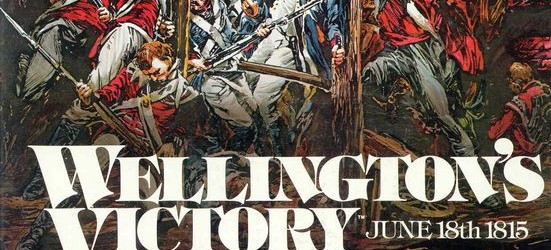
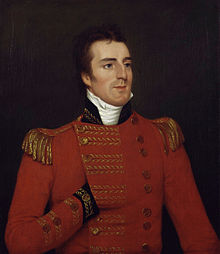

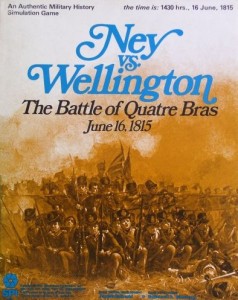
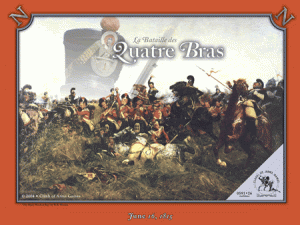

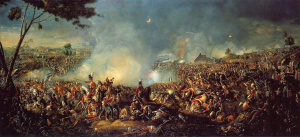
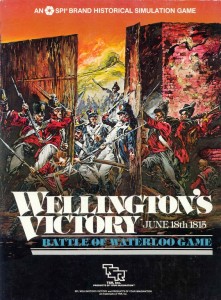
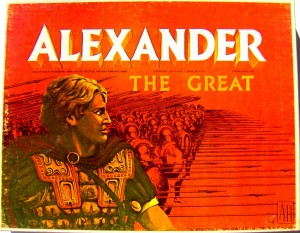






Nice analysis. I like your “Defense” painting as well. I’ve got WV setup, but I’m not really going to get any turns in before the 18th has passed.
Thank you.
It’s been many years since I’ve had Wellington’s Victory fully set up. I actually bought the game just after it first came out, nearly forty years ago. For reasons I can never quite fathom, I left my school on the morning in question with a horrible head cold, but instead of going home, I travelled to the other side of London with my Saturday job money in my pocket (no idea why I had it with me) and bought the game. The keenness of youth, I suppose!
Hope you enjoy your game.